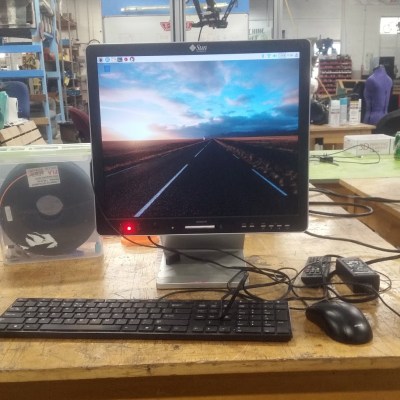One of the great predictions of desktop computing from the mid 1990s was that we would all move to so-called thin clients, stripped-out desktop computers containing only processor, display driver, and peripheral interfaces, that would call up their applications not from a local hard disk but from a remote server. It was one that was never fulfilled in quite the way its proponents envisaged, but a business thin client hardware market did emerge for the likes of Citrix sharing of Windows applications. In a sense we have reached the same point through cloud-based in-browser applications such as Google Apps or Office 365, though even with newer thin client hardware such as the Chromebook these are still largely used on more traditional machines.
 Even though thin clients never took the world by storm, it is still not unusual to encounter the hardware once it has outlived its usefulness. A surplus Sun Ray 270 all-in-one thin client came [Evan Allen]’s way, and to make something useful from it he converted it into a Raspberry Pi workstation.
Even though thin clients never took the world by storm, it is still not unusual to encounter the hardware once it has outlived its usefulness. A surplus Sun Ray 270 all-in-one thin client came [Evan Allen]’s way, and to make something useful from it he converted it into a Raspberry Pi workstation.
The Sun Ray 270 has a MIPS processor board integrated into a 17 inch monitor. [Evan] was fortunate enough to find a generic HDMI controller board for its LCD panel, so was able to dispense with the MIPS board entirely and couple the controller with an automatic HDMI switch. This allows him to use the device both as a Raspberry Pi and as a monitor.
This may not rank among the most epic hacks ever, but it has delivered [Evan] a useful computer and it’s reminding the rest of us that these thin clients can be repurposed. So if one lands on your bench, look at it with fresh eyes.
Of course, if you have a Pi in a thin client, you could always take it full circle and use it to run a thin client.
















MIPS? I thought the Sun Rays were SPARC?
*looks up the 270*
Hmm, truth is stranger than fiction… AMD Au1550, which is a MIPS32 chip, basically SPARC’s opposition. Perhaps I was thinking of the earlier JavaStations.
Sun Ray 1 was a 100MHz SPARC. SunRay 2 and 3 had MIPS SoCs.
Looks a nice build and the square monitor is a win for space. Recycling has to be good, stop the land fill and up cycle. :) Unfortunately I find it hard to live by that motto. Posts like this help me remember to stop being a consumer.
:)
The thin client model was the 90’s name for what is now “cloud computing”. Yet another round of the war between what started as the mainframe priesthood and distributed computing.
The “priesthood” just moved into new digs.
A fresh coat of paint, re-arrange the furniture and get marketing to call it “New and Improved”
The priesthood has stand-up desks now.
I should pack RasPis into my old DEC Multias. I think I still have one or two somewhere in my garage.
“though even with newer thin client hardware such as the Chromebook”
Why do people always say this? A Chromebook is just a laptop running a modified Ubuntu. It’s still Linux, still a desktop OS.
Sounds like minimalism is the new thin.
Because all it does is stream content. As was mentioned above the idea of streaming a video of your desktop was deemed too slow, so the current fad for thin clients is a box with just a web browser which renders the apps locally (gmail, office365, inventor fusion, facebook, etc…). Same idea, slightly different implementation to allow them to work efficiently over high latency connections.
You _could_ use a chromebook as a full linux computer, but then it would not be a chromebook anymore. I think google has been talking about adding the ability to run android apps from the local storage which would make it act more like a tablet, but the original chromebook idea was a laptop which has been locked down to only be a web browser. Not unlike the early java based thin clients…
It’s a rip off of the book:
The First $20 Million Is Always the Hardest
Because most “thin clients” are now just computers running a modified Windows or Linux installation.
I use a bunch of WYSE thin clients in a QA / test setup at my job.
They are X86 hardware with a 1gig local flash drive.
Needed a setup for automatic testing of our distributed software (VM’s didn’t suffice) and these showed up at around $50 compared to an alternative like a as us vivopc at $500.
Pxe boot, giga Ethernet and X86 was all I needed. Quite proud of that actually.
I used to pick up old WYSE thinclients for free/cheap when I could and repurpose the heck out of them. Great for little music servers or little machines to run older software.
I’ve used them for music synths, software-defined radio, the one I used most was a “thick” client (model with CDROM slot, PCI card and riser, etc) that was repurposed as a pfSense router. 50mbit routing pushed it to about 75% CPU though, so when I upgraded it had to go.
Incredibly handy little utility machines however, many have proper serial and parallel ports.